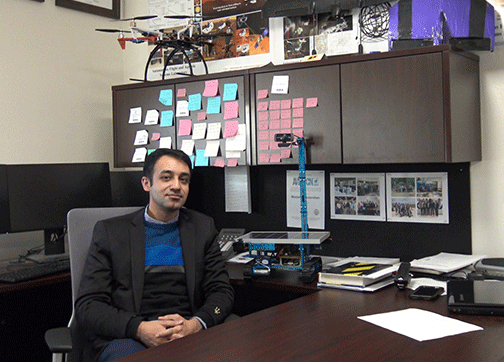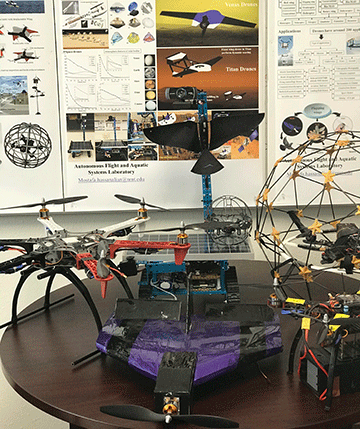Professor Examining Bird Formations To Make Drones More Efficient
February 25, 2020
SOCORRO, N.M. -- Recent publications by NMT professor Dr. Mostafa Hassanalian and grad student Amier Mirzaeinia are shedding light on how to make unmanned aerial vehicles more efficient – by observing how migratory birds conserve energy.
 The most recent paper was published in January 2020, titled “An analytical study on
leader and follower switching in V-shaped Canada Goose flocks for energy management
purposes.” Both papers focus on the swarming flight of the fixed-wing drones and a
load balancing mechanism. The first paper was published in October 2019 in the Aerospace
Science and Technology journal. Mirzaienia presented research at the 2019 Aviation
and Propulsion conference and the 2019 American Institute of Aeronautics and Astronautics
conference.
The most recent paper was published in January 2020, titled “An analytical study on
leader and follower switching in V-shaped Canada Goose flocks for energy management
purposes.” Both papers focus on the swarming flight of the fixed-wing drones and a
load balancing mechanism. The first paper was published in October 2019 in the Aerospace
Science and Technology journal. Mirzaienia presented research at the 2019 Aviation
and Propulsion conference and the 2019 American Institute of Aeronautics and Astronautics
conference.
Scientists have long known that migratory birds can conserve energy by flying in a V formation. However, Hassanalian (pictured above) and his team are specifically examining how birds rotate from lead to middle to rear positions.
Canada geese in particular can cover more than 2,000 kilometers in less than two days. Birds in the middle positions expend less energy, while birds in the front and the back expend more energy. Hassanalian is also looking at the northern bald ibis, which does not fly in a V formation, but in a single echelon.
The proximity of the Bosque del Apache National Wildlife Refuge has provided the NMT researchers with an accessible location to observe some migratory birds. Ultimately, he will be looking for funding to continue his research with airborne monitoring of migratory birds over long flights, as opposed to shorter observations in the Rio Grande Valley.
 Birds can conserve more than 40 percent of their energy by flying in formation and
switching positions regularly. Hassanalian and his grad students are using machine
learning to gain insight into how aircraft can become more efficient using the same
theories.
Birds can conserve more than 40 percent of their energy by flying in formation and
switching positions regularly. Hassanalian and his grad students are using machine
learning to gain insight into how aircraft can become more efficient using the same
theories.
(Pictured at right is a collection of Dr. Mostafa Hassanalian's drones.)
“We want to apply machine learning to this mechanism,” Hassanalian said. “We want to know how birds know when to rotate. If we program drones with our control algorithm, we can get the same benefit as birds. And we can use these algorithms for different types of drones.”
As an example, the swarm flight of EBee Sensfly flying wings is analyzed through the proposed methodology. Hassanalian’s work shows that drones can save up to 70 percent of their energy and consequently improve their performance when they fly in formation – or as a swarm. He currently has two graduate students working on this project -- Amir Mirzaienia and Niyem Bawana.
Hassanalian said this research could also have applications for commercial aviation. Airliners flying in formation could save significant amounts of fuel by flying in close formation.
“If you can merge flights and make a V formation, we can consume 40 percent less fuel,” Hassananlian said. “This is research is ongoing and we are always thinking about the next 100 years. So, once we get auto-navigation, airplanes could form a V formation and mimic migratory birds. If we program them with control algorithms, we can get the same benefit as birds.”
In the immediate future, Hassanalian said his concepts can be applied to all sizes of fixed-wing drones – from micro-drones that are as small 50 cm up to larger unmanned aerial vehicles.
Hassanalian’s group – the Autonomous Flight and Aquatic Systems Laboratory – has numerous other projects intended to improve drone efficiency by reducing drag. He has a biomimetics project that is studying how birds and some aquatic animals reduce drag by coloration. Orcas, dusky dolphins, and other aquatic species have been found to reduce drag because their upward facing sides are black and absorb heat. He is also studying space drones, aquatic drones, and drones intended for mine exploration.
– NMT –